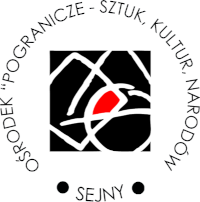The place of the performance was chosen not by a chance. Priest Wojciech Drozdowicz, a parson of the Post-Camaldolean Holly Maria's Immaculate Conception Church in Bielany Forest, has been a long-time friend of Teremiski university, and the room in the church's basement was an ideal for a stirring story about the tradition and the history.
On cold March evening the youth from the Borderland warmed up the Varsavians with their spontaneity and engagement with which they presented the stories from Sejny Chronicles. The rousing applause often broke the performance. The stories about the Jew Szmerko who could not accept the death of a beloved woman and who adored her corpse, about the "dziady" (beggars) begging for money at the church in Sejny, about the Gypsies wandering through the town, about the youth games, about the family trading the gees on the Polish-Lithuanian border - all them bedevilled the spectators with their simplicity.
There was also a piercing recollection of how Germans took all Jews from the village during the war. "- Probably they killed them all," narrated dramatically young actress.
The stories told yet not so long ago by grandparents fortunately did not take unnecessary poetical shape for the sake of performance. You could feel their authenticity. Jewish dances, Lithuanian and Russian Old-believers songs, and final entering of the young artists among the audience and sharing with them the stories - this is a way in which the Borderland is building the ties on many levels: between the generations, and between Sejnian and Varsavian equals. It is also a method to teach the respect for the tradition and history of your own home, clan, and society, a respect for polyphonic history learnt from those who lived it and often concerning everyday experience.
After the performance the audience did not let young artists leave the stage for about one hour, requesting to hear Lithuanian, Polish, and Russian songs. They were asking concrete titles - because some Varsavians have already managed to visit the Borderland in Sejny and learn in Sejny about its projects and activities. Some quickly joined Sejnian singers. It was indeed a great pleasure to listen to the strong, not any more childish voices. Accidental troubles that the artists had with singing some fragments were not a problem at all, because common attempts and common laughter was what really counted. "- It is like this with the songs - explained Bożena Szroeder, the director of the performance. - Some come easily, without exercising. Others can be sung many many times, and still escape from you."
Bożena Szroeder, who is also a co-founder of the Borderland Foundation, spoke about constantly developing story of the work on Sejny Chronicles. She has dealt with the Chronicles, together with young Sejny inhabitants, for six years. "- We wanted to use the growing knowledge that we had kept gathering. It could not be closed in one project only." Thus new ideas were being born: the exhibition of old Sejny postcards, the construction of the clay model of Sejny (half-mythical, as some no existing "but desirable" buildings were placed there too), the book Sejny Chronicles, and - recently - the project of the Historic Cards game. The audience in Camaldolean monaster also watched eighty cards (there would be more!), neatly (carefully) filled with the symbols referring each to a different Sejny story. All cards were designed by the young people from Sejny. The boys-actors explained some of the rules of the game - some of them because the rules are still being created, and the most important aim of the game, as Bożena Szroeder stressed, is to educate. "- We hope it to become an alternative for youngsters that spend so much time playing computer games. In future we are going to have our cards printed and disseminate at schools. They will be useful in teaching the local history." Not only the history of Sejny region, by the way. Danuta Kuroń dreams of bringing "the historic cards" to Warsaw. She wants children from "Gniazdos" (Nests) to follow the example of their Sejnian equals and wants them to work out - by means of cards - the history of their districts and the city.
Something will surely be born out of this cooperation. Already during the evening talks after the spectacle you could hear priest Wojciech expressing his admiration for a directing gift of the performance author and for the actors. "This room is waiting for you any time you wish to perform here," he declared. And the students from Teremiski are coming back to Sejnian Borderland this spring.


